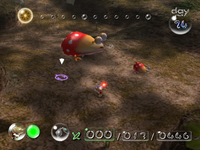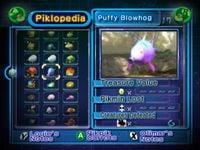Enemy
|
The following article or section is in need of assistance from someone who plays Pikmin 3. |
The Pikmin encounter a multitude of enemies on PNF-404. With few exceptions, these are both predators and prey, and they have varied characteristics and appearances. Defeating enemies constitutes a major part of gameplay in all Pikmin games.
Predator enemies have varied attacks, and some take the advantage of hazards to cause damage to Pikmin who are not immune to them. Offensively, enemies either eat Pikmin or hurt them with attacks, both melee and projectile-based, and with effects that range from pushing the Pikmin off to outright killing them. A few enemies are incapable of directly killing Pikmin.
Killed enemies may drop pellets, which can be brought to an Onion to exchange for Pikmin seeds. Defeated enemies that leave a corpse can also be returned to an Onion or the Research Pod, being exchanged for Pokos in the case of the latter. An enemy under the effect of an ultra-bitter spray will vanish when its health drops to zero; nectars or sprays then have a chance of dropping instead.
Some enemies contain important items like ship parts or treasures which they drop when defeated; these will still be dropped even if the creature was petrified. Most downed enemies will also safely release any Pikmin in their grasp, regardless of any apparently fatal damage caused when the Pikmin was trapped (like the Cloaking Burrow-nit's impalement). This allows otherwise doomed Pikmin to be saved.
Bosses
|
To do: Add the Pikmin 3 loading screen tip that goes like "Boss enemies you hurt will stay hurt the next day" as a reference to the end of the second paragraph. |
Some particular types of enemies are larger or stronger than the other, more common ones, but appear less frequently. These are known as bosses, and normally only one or two of each type appear in the entire game. Given that battles against them are usually more difficult, the rewards tend to be better, such as a large number of Pikmin seeds, Pokos, or an important story-related item.
Through each game in the series, the definition of a "boss" has become progressively clearer. In Pikmin, the game seldom makes a distinction between a boss and a regular enemy. In Pikmin 2, bosses are given their own slots on the Piklopedia and a specific musical theme, with some even having unique ones. Finally, in Pikmin 3, bosses are clearly identified as such by the game itself, and are divided between main boss and mini-boss.
In Pikmin, it is assumed by fans that a boss is any enemy that appears once or twice in the main story mode and does not return once defeated. Bosses are also seen as strong creatures that, without proper care, can decrease a player's Pikmin count sharply; as such, the Breadbug is not recognized as a boss by fans. Some bosses are more clearly labeled as such, however: when fighting the Beady Long Legs or Emperor Bulblax, specific music themes play.
In Pikmin 2, all bosses use a special boss theme, and the ones that do not use their own unique theme, specifically the Titan Dweevil, the Waterwraith and the Giant Breadbug. They also appear in a larger bubble on the Piklopedia's listing. In Pikmin 3, the main bosses are clearly labeled by the game, and their battles are considerably more complex than with most other enemies. These bosses can be re-fought in special Mission Mode stages. They normally have clearly define vulnerability and invulnerability phases, commonly attacking during the latter. Other, less notable bosses appear in Pikmin 3 as well, and are normally distinguished by fans as mini-bosses. These do not give out something plot-critical when defeated, and have a different music theme. Also, in Pikmin 3, main bosses will keep their health when the day ends. Boss corpses will also last until the next day, but not any longer. Both of these do not go for the mini-bosses, however.
A list of bosses (normal and mini) can be found Category:Bosses, and is also present in this article's lists, as entires in bold.
Music
- Main article: Music.
When fighting bosses, the music of the area or cave is changed to a different theme that lasts for as long as all bosses in the vicinity are alive. In Pikmin, this is only the case for the Beady Long Legs and the Emperor Bulblax, with each one having their own theme. In Pikmin 2, a global boss theme exists, and plays whenever a living boss is nearby. This theme changes dynamically with the events happening in the fight. The following bosses have their own specific boss themes: Waterwraith, Giant Breadbug and Titan Dweevil. In Pikmin 3, two boss themes exist – one for the major bosses and another for the mini-bosses. The exceptions to this are the Vehemoth Phosbat and the Plasm Wraith, which have their own themes. The mini-boss theme is a remastered version of the Pikmin 2 boss music.
Behavior
Most enemies roam around in a specific location of the area, leaving only to chase after or run away from Pikmin or leaders. Some enemies are quite dedicated to their initial spots, returning to it after wandering too far. The locations in which enemies can be found sometimes depends on their nature. For instance, the fur-coated Hairy Bulborbs are better suited to cold environments, and as such, as commonly found in ice-themed caves.
Enemies are normally killed by Pikmin attacks, which becomes easier the more Pikmin are attacking. They can also inadvertently kill themselves by ingesting White Pikmin, falling off pits, or rarely, by coming into contact with certain hazards.
As threats to Pikmin, enemies can attack in a variety of ways, the most common one being eating them. They can also crush them, kill them with a hazard they're vulnerable to, and knock them out with an explosion, amongst other methods. For some of these attacks, there is a cap on the number of Pikmin that can be affected from it. For instance, in Pikmin, a Red Bulborb may only grab and eat three Pikmin at most, with a single bite, but in Pikmin 2, five can fall prey to the same bite.
Interactions
For the most part, every enemy is its own entity, interacting only with the Pikmin and leaders. Some enemies, however, have passive or active interactions with the environment, other enemies, or miscellaneous objects.
Environment interactions
- In Pikmin 3, most enemies will be unable to detect Pikmin and leaders if they are hiding under tall plants.
- In Pikmin 2, if an Emperor Bulblax gets close to a bomb-rock, it will eat it without needing to be coaxed into doing so.
- The fire on a Fiery Bulblax's back will be put out should it go into water. It will reignite once the enemy leaves.
- If a member of the Mandiblard family touches water, it will steadily lose health.
Cooperation
Some creatures keep a bond with others. To maximize the chances of survival, some enemies can be seen next to others, normally of their own species, and oftentimes interacting with them when a fight for survival is taking place. Dwarf Red Bulborbs, Dwarf Bulbears, etc. are often found next to larger enemies of the same species or of the species they are mimicking. When under attack, they may scream in order to wake up their larger allies.
Other creatures choose to follow a leader, normally of their own family. An example is the Bulbmin, who lose all sense of control should their leader perish, and the Scornets, who obey the command of the Scornet Maestro.
Hostility
Hostility between enemies is non-existent, but cases of enemies damaging each other are not. Some enemies may, if inadvertently, hurt others. This normally happens when they try to kill Pikmin or leaders. Not many enemy attacks are made to hurt others, but the following exceptions exist:
- The Empress Bulblax can kill its young by rolling into them.
- A Gatling Groink can damage other enemies with its shots.
- A Lithopod's boulders can harm other enemies or even the launcher itself.
- The Raging Long Legs and Baldy Long Legs can stomp on and kill other enemies, particularly on the Angle Maze and Tropical Forest, respectively.
- Volatile Dweevils and Careening Dirigibugs can harm other enemies with their bomb-rocks.
- In Pikmin 3, Yellow Wollywogs can kill or injure other enemies if they land on them.
As a gameplay element
In the games, enemies locations are relatively evenly spread, in order to maximize the balance between exploration and combat, as to not overwhelm the player. More important locations, however, are generally covered by stronger enemies, requiring the player to excel in combat skill if they are to obtain the rewards that lie behind them. Analogously, easier enemies are encountered closer to the landing sites and the first floors of caves.
Enemies that are killed do not reappear until the leaders leave, regardless of leaving a corpse. Some enemies do however respawn after an in-game day has passed, or after a cave is entered and exited, although others might require the passing of some full days before returning. In addition, some only appear in specific days, as is the case with the Goolix and the Mamuta on The Impact Site. Besides respawning, some enemies can actually revive after they've been considered dead, and a few have a natural health regeneration mechanic.
Intelligence-wise, enemies have a very simplistic artificial intelligence system. Some bosses are hard-coded to perform more specific actions and reply to more specific events, but for the most part, enemies can recognize the presence of a Pikmin, when to attack, when to shake Pikmin off, when to return to their home spot, and not much else. On top of that, their path recognition systems are non-existent: when they want to reach a spot, they head directly towards it, with no regard to any walls or obstacles. Most of the time there are no obstacles in the way (or if there are, they can be slid through), but otherwise, this can lead to them getting stuck behind them, endlessly walking in place.
This simplicity, however, is required to minimize the development costs and the processor usage, given that more complex path recognition systems could end up lowering the game's framerate. Another trick to minimize processor usage is to simply not render or recognize any enemy that lies beyond the camera's reach. These tricks allow the game to run smoothly without severely compromising the game and the enemies' livelihood.
List
The following is a list of enemies in the Pikmin series. Names in bold belong to enemies that are considered bosses. You may also browse the available categories on Pikipedia, with the top one being Enemies.
Enemies in Pikmin
- Category: Pikmin 1 enemies
Enemies in Pikmin 2
- Category: Pikmin 2 enemies. Read Piklopedia for a more detailed list.
Enemies in Pikmin 3
Category: Pikmin 3 enemies
In-game encyclopedias
- Main articles: Enemy reel and Piklopedia.
The enemy reel is a special movie at the end of Pikmin. It showcases short clips featuring all enemies in the game, accompanied by a minor description of each.
The Piklopedia is a catalog of enemies and plants, available before entering an area at the start of a day in Pikmin 2. This list is filled with enemy entries as they are killed in the game. Each entry also details the amount of Pokos the enemy is worth, how many of them have been killed so far, Olimar and Louie's notes, and it allows the player to view them roaming around and eat thrown Pikpik carrots, using a free camera mode.
Names in other languages
| Language | Name | Meaning | Notes |
|---|---|---|---|
| Inimigo | Enemy | Translation taken from the Pikmin instruction manual. |

